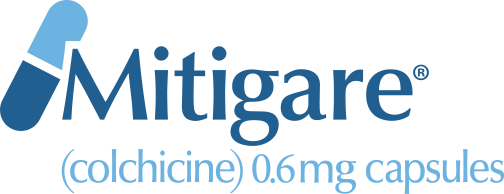
Wear Blue for Gout!
Gout Awareness Day, held every year on May 22, is more than just a good reason to wear blue—it’s a great opportunity to educate others about gout, promote understanding of the disease and rally support for the people who live with it every day. If you’re not familiar with gout, you can learn more about it below. If you have gout, consider sharing this post with family and friends to teach them more about the disease. Whether you’re actively participating in Gout Awareness Day activities this year or simply making an effort to live better with the condition, you are an important part of this annual event.
What is gout?
Gout is a common form of inflammatory arthritis caused by excess uric acid in the bloodstream.1 When the amount of uric acid level remains high over time, it can cause urate crystals to form around a joint (the big toe usually is the first part of the body affected).1,2 Although gout is considered a chronic condition, many people manage it with medicine and lifestyle changes.3
Who gets gout?
Approximately 9 million Americans suffer with gout, and men are three times more likely than women to develop the disease.3,4 People with certain health conditions, including obesity, heart failure, high blood pressure, diabetes and kidney disease, face an increased risk as well.3 Age can also be a factor—most men with gout develop the condition in their forties or fifties, and women tend to develop it after menopause.2,5
What causes gout?
For many years, gout was associated with eating rich foods and indulging in alcoholic beverages.6 While a person’s lifestyle may contribute to their risk of gout flares, research indicates that heredity may also be to blame.7,8 Data from studies published in 2017 and 2018 show that gout tends to run in families.7,8
What can trigger gout flares?
A gout flare, also known as a gout attack, is considered to be one of the most painful experiences a person can have.9 Gout flares can be triggered when the urate crystals surrounding a joint are disturbed.10 This disturbance can cause a joint to become red, swollen, inflamed and extremely painful.10,11 A number of factors can increase the risk of flares.11 To learn more about what might be triggering your gout flares, click here.
When should I see a doctor for my gout?
If you find yourself experiencing the excruciating pain of a gout flare, contact your doctor as soon as you can. He or she can examine your affected joint and conduct tests to determine if gout is indeed the source of your pain.12 Your doctor may also be able to recommend medications you can take or other things you can do to manage the disease.12
How is gout diagnosed?
Your doctor may diagnose you with gout based on the symptoms you describe and the appearance of your affected joint.12 He or she might also order a blood test (to check the uric acid level in your bloodstream), a joint fluid test (to see if urate crystals are present in the fluid surrounding the joint) and/or other assessments including X-ray imaging, ultrasound and dual-energy computerized tomography.12
How should I manage my gout?
Your doctor may recommend medication and lifestyle changes.12 Medications can help reduce your risk of gout flares and complications related to the disease.12 A gout medicine called urate-lowering therapy, or ULT, can help address the root cause of gout by helping to reduce the amount of uric acid in your bloodstream.12 An anti-inflammatory medicine such as colchicine (eg, Mitigare® [Colchicine] 0.6mg Capsules or Authorized Generic Colchicine 0.6mg Capsules) can be taken to prevent flares.12,13 Flare prevention is especially important with ULT because ULT can actually make you more prone to flares when you first begin taking it.10
Why is it so important to manage my gout?
Gout is a serious disease that must be controlled.6,14 While gout flares are unpleasant, having excess uric acid in your body can cause other health problems beyond a painful big toe.14 According to the Arthritis Foundation, excess uric acid can damage the kidneys, blood vessels and other organs.14 Having gout also raises your risk of other disorders, specifically kidney and cardiovascular disease, diabetes, depression and sleep apnea.14 And advanced gout, if left untreated, can lead to the same level of work loss, physical disability and diminished quality of life as is seen in advanced rheumatoid arthritis.6
Is there a cure for gout?
According to the Centers for Disease Control and Prevention, there is no cure for gout.15 However, you don’t have to live in fear of gout attacks.15 For many people, gout can be effectively controlled with medication and lifestyle changes.15 If you have gout, it is important to stay in close contact with your doctor because he or she can help you manage the condition and maintain your health. Be sure to keep all of your scheduled appointments, and make sure your doctor is up to date on:
- Your gout symptoms (how and when your gout attacks occur)
- Recent changes or stresses in your life (such as a change in your work or family situation)
- The medications and supplements you take
You might also consider tracking your gout flares and sharing this information with your doctor at your appointments.
Gout Awareness Day
Mitigare® is a registered trademark of Hikma Pharmaceuticals USA Inc.
Colchicine 0.6 mg capsules are contraindicated in patients with renal or hepatic impairment who are currently prescribed drugs that inhibit both P-gp and CYP3A4. Combining these dual inhibitors with colchicine in patients with renal or hepatic impairment has resulted in life-threatening or fatal colchicine toxicity. Patients with both renal and hepatic impairment should not be given Mitigare®.
Fatal overdoses have been reported with colchicine in adults and children. Keep Mitigare® out of the reach of children.
Blood dyscrasias such as myelosuppression, leukopenia, granulocytopenia, thrombocytopenia and aplastic anemia have been reported with colchicine used in therapeutic doses.
Monitor for toxicity and, if present, consider temporary interruption or discontinuation of colchicine.
Drug interaction with dual P-gp and CYP3A4 inhibitors: Co-administration of colchicine with dual P-gp and CYP3A4 inhibitors has resulted in life-threatening interactions and death.
Neuromuscular toxicity and rhabdomyolysis may occur with chronic treatment with colchicine in therapeutic doses, especially in combination with other drugs known to cause this effect. Patients with impaired renal function and elderly patients (including those with normal renal and hepatic function) are at increased risk. Consider temporary interruption or discontinuation of Mitigare®.
The most commonly reported adverse reactions with colchicine are gastrointestinal symptoms, including diarrhea, nausea, vomiting and abdominal pain.
Please see the full Prescribing Information and Medication Guide for Mitigare® for complete product details.
NOTE: This article was not written by a medical professional and is not intended to substitute for the guidance of a physician. These are not Hikma’s recommendations for gout flare prevention, but rather facts and data collected from various reliable medical sources. For a full list of resources and their attributing links, see below.
